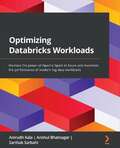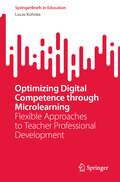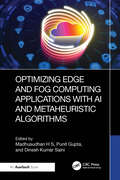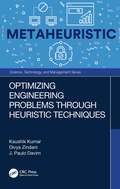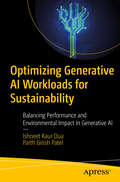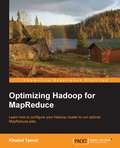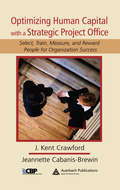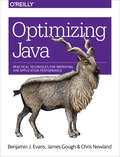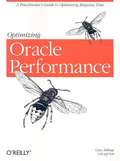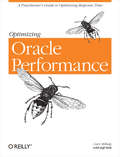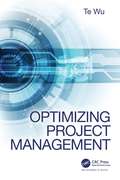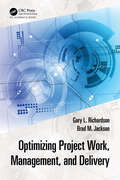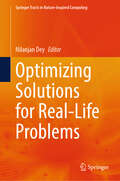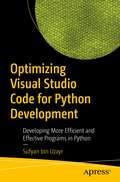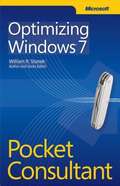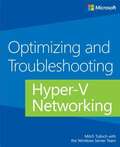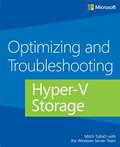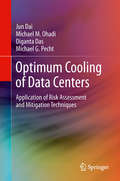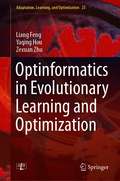- Table View
- List View
Optimizing Databricks Workloads: Harness the power of Apache Spark in Azure and maximize the performance of modern big data workloads
by Anirudh Kala Anshul Bhatnagar Sarthak SarbahiAccelerate computations and make the most of your data effectively and efficiently on DatabricksKey FeaturesUnderstand Spark optimizations for big data workloads and maximizing performanceBuild efficient big data engineering pipelines with Databricks and Delta LakeEfficiently manage Spark clusters for big data processingBook DescriptionDatabricks is an industry-leading, cloud-based platform for data analytics, data science, and data engineering supporting thousands of organizations across the world in their data journey. It is a fast, easy, and collaborative Apache Spark-based big data analytics platform for data science and data engineering in the cloud.In Optimizing Databricks Workloads, you will get started with a brief introduction to Azure Databricks and quickly begin to understand the important optimization techniques. The book covers how to select the optimal Spark cluster configuration for running big data processing and workloads in Databricks, some very useful optimization techniques for Spark DataFrames, best practices for optimizing Delta Lake, and techniques to optimize Spark jobs through Spark core. It contains an opportunity to learn about some of the real-world scenarios where optimizing workloads in Databricks has helped organizations increase performance and save costs across various domains.By the end of this book, you will be prepared with the necessary toolkit to speed up your Spark jobs and process your data more efficiently.What you will learnGet to grips with Spark fundamentals and the Databricks platformProcess big data using the Spark DataFrame API with Delta LakeAnalyze data using graph processing in DatabricksUse MLflow to manage machine learning life cycles in DatabricksFind out how to choose the right cluster configuration for your workloadsExplore file compaction and clustering methods to tune Delta tablesDiscover advanced optimization techniques to speed up Spark jobsWho this book is forThis book is for data engineers, data scientists, and cloud architects who have working knowledge of Spark/Databricks and some basic understanding of data engineering principles. Readers will need to have a working knowledge of Python, and some experience of SQL in PySpark and Spark SQL is beneficial.
Optimizing Digital Competence through Microlearning: Flexible Approaches to Teacher Professional Development (SpringerBriefs in Education)
by Lucas KohnkeThis book examines teacher professional development (TPD) models to integrate microlearning into TPD training and serves as a concise but comprehensive introduction to the field. This book covers critical teacher professional development and microlearning aspects, including artificial intelligence, virtual reality, augmented reality, and mixed modalities. It is an important starting point for teachers, teacher-trainers, academics, and researchers interested in the principles and practices in teacher professional development through microlearning.
Optimizing Digital Strategy: How to Make Informed, Tactical Decisions that Deliver Growth
by James Hammersley Professor Christopher Bones Nick ShawOptimizing Digital Strategy explores the choices facing organizations in the rapidly changing world of technology-enabled business. From performance marketing through to personalization, on-demand retailing and AI, this book maps out commercial and customer-focused challenges and explains how leaders can get the most out of their digital strategies. Rather than rushing headlong into adopting the latest digital platforms, tools and technologies, the book challenges leaders to step back from the demands for constant investment in new technology and drive better returns from existing assets. Presenting a sustainable model of e-commerce that is appropriate to any individual organization's needs, Optimizing Digital Strategy addresses the repetitive dilemma between even more investment in technology and the need to improve margins and grow revenue. Illustrated by the authors' own digital work for global brands such as The Economist, Sky, O2, Regus, the Financial Times, Lidl and L.K.Bennett, this book shows how to balance the need to remain competitive, fully deliver customer expectations, and put resources behind investments that will deliver the best return.
Optimizing Edge and Fog Computing Applications with AI and Metaheuristic Algorithms
by Punit Gupta Dinesh Kumar Saini Madhusudhan H SFog and edge computing are two paradigms that have emerged to address the challenges associated with processing and managing data in the era of the Internet of Things (IoT). Both models involve moving computation and data storage closer to the source of data generation, but they have subtle differences in their architectures and scopes. These differences are one of the subjects covered in Optimizing Edge and Fog Computing Applications with AI and Metaheuristic Algorithms. Other subjects covered in the book include: Designing machine learning (ML) algorithms that are aware of the resource constraints at the edge and fog layers ensures efficient use of computational resources Resource-aware models using ML and deep leaning models that can adapt their complexity based on available resources and balancing the load, allowing for better scalability Implementing secure ML algorithms and models to prevent adversarial attacks and ensure data privacy Securing the communication channels between edge devices, fog nodes, and the cloud to protect model updates and inferences Kubernetes container orchestration for fog computing Federated learning that enables model training across multiple edge devices without the need to share raw data The book discusses how resource optimization in fog and edge computing is crucial for achieving efficient and effective processing of data close to the source. It explains how both fog and edge computing aim to enhance system performance, reduce latency, and improve overall resource utilization. It examines the combination of intelligent algorithms, effective communication protocols, and dynamic management strategies required to adapt to changing conditions and workload demands. The book explains how security in fog and edge computing requires a combination of technological measures, advanced techniques, user awareness, and organizational policies to effectively protect data and systems from evolving security threats. Finally, it looks forward with coverage of ongoing research and development, which are essential for refining optimization techniques and ensuring the scalability and sustainability of fog and edge computing environments.
Optimizing Engineering Problems through Heuristic Techniques (Science, Technology, and Management)
by J. Paulo Davim Kaushik Kumar Divya ZindaniThis book will cover heuristic optimization techniques and applications in engineering problems. The book will be divided into three sections that will provide coverage of the techniques, which can be employed by engineers, researchers, and manufacturing industries, to improve their productivity with the sole motive of socio-economic development. This will be the first book in the category of heuristic techniques with relevance to engineering problems and achieving optimal solutions. Features Explains the concept of optimization and the relevance of using heuristic techniques for optimal solutions in engineering problems Illustrates the various heuristics techniques Describes evolutionary heuristic techniques like genetic algorithm and particle swarm optimization Contains natural based techniques like ant colony optimization, bee algorithm, firefly optimization, and cuckoo search Offers sample problems and their optimization, using various heuristic techniques
Optimizing Generative AI Workloads for Sustainability: Balancing Performance and Environmental Impact in Generative AI
by Ishneet Kaur Dua Parth Girish PatelThis comprehensive guide provides practical strategies for optimizing Generative AI systems to be more sustainable and responsible. As advances in Generative AI such as large language models accelerate, optimizing these resource-intensive workloads for efficiency and alignment with human values grows increasingly urgent. The book starts with the concept of Generative AI and its wide-ranging applications, while also delving into the environmental impact of AI workloads and the growing importance of adopting sustainable AI practices. It then delves into the fundamentals of efficient AI workload management, providing insights into understanding AI workload characteristics, measuring performance, and identifying bottlenecks and inefficiencies. Hardware optimization strategies are explored in detail, covering the selection of energy-efficient hardware, leveraging specialized AI accelerators, and optimizing hardware utilization and scheduling for sustainable operations. You are also guided through software optimization techniques tailored for Generative AI, including efficient model architecture, compression, and quantization methods, and optimization of software libraries and frameworks. Data management and preprocessing strategies are also addressed, emphasizing efficient data storage, cleaning, preprocessing, and augmentation techniques to enhance sustainability throughout the data life cycle. The book further explores model training and inference optimization, cloud and edge computing strategies for Generative AI, energy-efficient deployment and scaling techniques, and sustainable AI life cycle management practices, and concludes with real-world case studies and best practices By the end of this book, you will take away a toolkit of impactful steps you can implement to minimize the environmental harms and ethical risks of Generative AI. For organizations deploying any type of generative model at scale, this essential guide provides a blueprint for developing responsible AI systems that benefit society. What You Will Learn Understand how Generative AI can be more energy-efficient through improvements such as model compression, efficient architecture, hardware optimization, and carbon footprint tracking Know the techniques to minimize data usage, including evaluation, filtering, synthesis, few-shot learning, and monitoring data demands over time Understand spanning efficiency, data minimization, and alignment for comprehensive responsibility Know the methods for detecting, understanding, and mitigating algorithmic biases, ensuring diversity in data collection, and monitoring model fairness Who This book Is For Professionals seeking to adopt responsible and sustainable practices in their Generative AI work; leaders and practitioners who need actionable strategies and recommendations that can be implemented directly in real-world systems and organizational workflows; ML engineers and data scientists building and deploying Generative AI systems in industry settings; and researchers developing new generative AI techniques, such as at technology companies or universities
Optimizing HPC Applications with Intel® Cluster Tools: Hunting Petaflops
by Alexander Supalov Andrey Semin Michael Klemm Christopher DahnkenOptimizing HPC Applications with Intel® Cluster Tools takes the reader on a tour of the fast-growing area of high performance computing and the optimization of hybrid programs. These programs typically combine distributed memory and shared memory programming models and use the Message Passing Interface (MPI) and OpenMP for multi-threading to achieve the ultimate goal of high performance at low power consumption on enterprise-class workstations and compute clusters. The book focuses on optimization for clusters consisting of the Intel® Xeon processor, but the optimization methodologies also apply to the Intel® Xeon Phi(tm) coprocessor and heterogeneous clusters mixing both architectures. Besides the tutorial and reference content, the authors address and refute many myths and misconceptions surrounding the topic. The text is augmented and enriched by descriptions of real-life situations. What you'll learn Practical, hands-on examples show how to make clusters and workstations based on Intel® Xeon processors and Intel® Xeon Phi(tm) coprocessors "sing" in Linux environments How to master the synergy of Intel® Parallel Studio XE 2015 Cluster Edition, which includes Intel® Composer XE, Intel® MPI Library, Intel® Trace Analyzer and Collector, Intel® VTune(tm) Amplifier XE, and many other useful tools How to achieve immediate and tangible optimization results while refining your understanding of software design principles Who this book is for Software professionals will use this book to design, develop, and optimize their parallel programs on Intel platforms. Students of computer science and engineering will value the book as a comprehensive reader, suitable to many optimization courses offered around the world. The novice reader will enjoy a thorough grounding in the exciting world of parallel computing. Table of Contents Foreword by Bronis de Supinski, CTO, Livermore Computing, LLNL Introduction Chapter 1: No Time to Read this Book? Chapter 2: Overview of Platform Architectures Chapter 3: Top-Down Software Optimization Chapter 4: Addressing System Bottlenecks Chapter 5: Addressing Application Bottlenecks: Distributed Memory Chapter 6: Addressing Application Bottlenecks: Shared Memory Chapter 7: Addressing Application Bottlenecks: Microarchitecture Chapter 8: Application Design Considerations
Optimizing Hadoop for MapReduce
by Khaled TannirThis book is an example-based tutorial that deals with Optimizing Hadoop for MapReduce job performance. If you are a Hadoop administrator, developer, MapReduce user, or beginner, this book is the best choice available if you wish to optimize your clusters and applications. Having prior knowledge of creating MapReduce applications is not necessary, but will help you better understand the concepts and snippets of MapReduce class template code.
Optimizing Human Capital with a Strategic Project Office: Select, Train, Measure,and Reward People for Organization Success (PM Solutions Research)
by Jeannette Cabanis-Brewin J. Kent CrawfordOptimizing Human Capital with a Strategic Project Office explores the SPO's potential to transform an enterprise by making the most of people within an organization. This volume provides an exhaustive review of topics such as the hiring, retention, measurement, training, and professional development of knowledge workers in project management
Optimizing Java: Practical Techniques for Improving JVM Application Performance
by Benjamin J Evans James Gough Chris NewlandPerformance tuning is an experimental science, but that doesn’t mean engineers should resort to guesswork and folklore to get the job done. Yet that’s often the case. With this practical book, intermediate to advanced Java technologists working with complex technology stacks will learn how to tune Java applications for performance using a quantitative, verifiable approach.Most resources on performance tend to discuss the theory and internals of Java virtual machines, but this book focuses on the practicalities of performance tuning by examining a wide range of aspects. There are no simple recipes, tips and tricks, or algorithms to learn. Performance tuning is a process of defining and determining desired outcomes. And it requires diligence.Learn how Java principles and technology make the best use of modern hardware and operating systemsExplore several performance tests and common anti-patterns that can vex your teamUnderstand the pitfalls of measuring Java performance numbers and the drawbacks of microbenchmarkingDive into JVM garbage collection logging, monitoring, tuning, and toolsExplore JIT compilation and Java language performance techniquesLearn performance aspects of the Java Collections API and get an overview of Java concurrency
Optimizing Oracle Performance
by Cary MillsapOracle DBAs and developers are all too familiar with the outlay of time and resources, blown budgets, missed deadlines, and marginally effective performance fiddling that is commonplace with traditional methods of Oracle performance tuning. In Optimizing Oracle Performance , Cary Millsap, former VP of Oracle's System Performance Group, clearly and concisely explains how to use Oracle's response time statistics to diagnose and repair performance problems. Cary also shows how "queueing theory" can be applied to response time statistics to predict the impact of upgrades and other system changes. The price of this essential book will be paid back in hours saved the first time its methods are used.
Optimizing Oracle Performance: A Practitioner's Guide to Optimizing Response Time
by Cary Millsap Jeff HoltOracle system performance inefficiencies often go undetected for months or even years--even under intense scrutiny--because traditional Oracle performance analysis methods and tools are fundamentally flawed. They're unreliable and inefficient.Oracle DBAs and developers are all too familiar with the outlay of time and resources, blown budgets, missed deadlines, and marginally effective performance fiddling that is commonplace with traditional methods of Oracle performance tuning. In this crucial book, Cary Millsap, former VP of Oracle's System Performance Group, clearly and concisely explains how to use Oracle's response time statistics to diagnose and repair performance problems. Cary also shows how "queueing theory" can be applied to response time statistics to predict the impact of upgrades and other system changes.Optimizing Oracle Performance eliminates the time-consuming, trial-and-error guesswork inherent in most conventional approaches to tuning. You can determine exactly where a system's performance problem is, and with equal importance, where it is not, in just a few minutes--even if the problem is several years old.Optimizing Oracle Performance cuts a path through the complexity of current tuning methods, and streamlines an approach that focuses on optimization techniques that any DBA can use quickly and successfully to make noticeable--even dramatic--improvements.For example, the one thing database users care most about is response time. Naturally, DBAs focus much of their time and effort towards improving response time. But it is entirely too easy to spend hundreds of hours to improve important system metrics such as hit ratios, average latencies, and wait times, only to find users are unable to perceive the difference. And an expensive hardware upgrade may not help either.It doesn't have to be that way. Technological advances have added impact, efficiency, measurability, predictive capacity, reliability, speed, and practicality to the science of Oracle performance optimization. Optimizing Oracle Performance shows you how to slash the frustration and expense associated with unraveling the true root cause of any type of performance problem, and reliably predict future performance.The price of this essential book will be paid back in hours saved the first time its methods are used.
Optimizing Play: Why Theorycrafting Breaks Games and How to Fix It
by Christopher A. PaulAn unexpected take on how games work, what the stakes are for them, and how game designers can avoid the traps of optimization.The process of optimization in games seems like a good thing—who wouldn&’t want to find the most efficient way to play and win? As Christopher Paul argues in Optimizing Play, however, optimization can sometimes risk a tragedy of the commons, where actions that are good for individuals jeopardize the overall state of the game for everyone else. As he explains, players inadvertently limit play as they theorycraft, seeking optimal choices. The process of developing a meta, or the most effective tactic available, structures decision making, causing play to stagnate. A &“stale&” meta then creates a perception that a game is solved and may lead players to turn away from the game.Drawing on insights from game studies, rhetoric, the history of science, ecology, and game theory literature, Paul explores the problem of optimization in a range of video games, including Overwatch, FIFA/EA Sports FC, NBA 2K, Clash Royale, World of Warcraft, and League of Legends. He also pulls extensively from data analytics in sports, where the problem has progressed further and is even more intractable than it is in video games, given the money sports teams invest to find an edge. Finally, Paul offers concrete and specific suggestions for how games can be developed to avoid the trap set by optimization run amok.
Optimizing Project Management
by Te WuSHELVING GUIDE: Project Management This hands-on guide is written for project professionals seeking to find an optimized way of performing project management. It provides answers to such critical questions as: Why should an organization apply project management? What is the value of project management in the broader context of an organization? Is project management as successful as some advocates suggested or is it a waste of time and resources because of the many extensive and bureaucratic processes? Which project management approach should our project team adopt: predictive or adaptive, waterfall or rolling water, extreme programming or Scrum? This book aims to provide an optimized view of project management by balancing and blending competing methodologies (e.g., traditional versus Agile), lengthy methodologies and broad principles, processes and practices, and the need to understand versus the need to apply. It includes project management templates, an integrated case study illustrating how to apply tools and concepts, and a glossary of key terms. Optimizing Project Management is for both aspiring and practicing project management professionals. It covers the core concepts, practices, and skills that are useful for developing new ideas, planning activities, implementing projects, and conducting planning and controlling of schedule, budget, and scope. The text is particularly useful for students, project professionals wanting to refresh their knowledge, and those pursuing project management certifications. This book is aligned with common project management standards such as the Project Management Body of Knowledge and the ISO 21502: Project, Programme and Portfolio Management — Guidance on Project Management.
Optimizing Project Work, Management, and Delivery
by Gary L. Richardson Brad M. JacksonThousands of project management–related books have been written. Why is Optimizing Project Work, Management, and Delivery different? This book represents the authors’ experiences gained from looking at the problem of project management for 50 years and wondering why projects cannot be more successful. Experience from various management models and techniques has helped but still does not fit reality or provide accurate forecasts. Industry surveys have compiled the root causes of project failure, and yet they persist. Is there no answer to this problem? As the book explains, the management solution is not in the models or the theory but is found in how they are mapped against the actual target project characteristics. This is the book’s unique strength. There are major coverage gaps in current project management models that also need to be recognized. All of the existing models are correct in some ways, and yet each is also wrong. The book starts by reviewing popular models and related topics that help construct the building blocks of an integrated model structure, which is at the core of this book. The integrated model described here is meant to be a decision-oriented view related to the project life cycle rather than a cookbook of success steps. Project management is too complex for a cookbook approach. This text helps managers find that right path.
Optimizing Smart and Sustainable Agriculture for Sustainability (Future Generation Information Systems)
by Joel J. P. C. Rodrigues Ankita Bansal Abha Jain Biswaranjan Acharya Rachna JainThis reference text addresses the importance of smart crop management for increasing yield and presents a framework for smart monitoring and regulation of crop observation. Further, it comprehensively covers important topics such as spatial decision support systems for precision farming, swarm intelligence in the optimal management of aquaculture farms, and intelligent harvesting algorithms for improving productivity.This book:• Presents meta-heuristic algorithms for optimization, economic crop planning, and use of effective water resource management.• Discusses spatial decision support systems for crop productivity management, watershed management, and precision farming.• Illustrates swarm intelligence-based optimization techniques, data mining, and machine learning methods for aquaculture operations.• Highlights artificial intelligence and machine learning-based harvesting algorithms for improving productivity.• Explains the use of green Internet of Things security solutions for agriculture, plant condition management, and greenhouse simulation.It is primarily written for graduate students and academic researchers in the fields of electrical engineering, electronics and communication engineering, computer science and engineering, agricultural science, and information technology.
Optimizing Solutions for Real-Life Problems (Springer Tracts in Nature-Inspired Computing)
by Nilanjan DeyThis book explores various optimization techniques that can be used to address problems in the real world. These problems can be found in healthcare, engineering, manufacturing, and many other fields. In many real-world situations, from business to science, optimization techniques are similar to problem-solving tools. They help us make the best choices by considering limitations (constraints) and what we are trying to achieve (objectives). These techniques sift through all the possibilities and find the most effective option. Optimization is similar to a toolbox filled with different problem-solving methods, such as linear programming or genetic algorithms. These tools help us make better decisions about allocating resources across many different fields. They do this by finding the most efficient and effective solutions, considering all the limitations and goals involved.
Optimizing Visual Studio Code for Python Development: Developing More Efficient and Effective Programs in Python
by Sufyan bin UzayrLearn Visual Studio Code and implement its features in Python coding, debugging, linting, and overall project management. This book addresses custom scenarios for writing programs in Python frameworks, such as Django and Flask.The book starts with an introduction to Visual Studio Code followed by code editing in Python. Here, you will learn about the required extensions of Visual Studio Code to perform various functions such as linting and debugging in Python. Next, you will set up the environment and run your projects along with the support for Jupyter. You will also work with Python frameworks such as Django and go through data science specific-information and tutorials. Finally, you will learn how to integrate Azure for Python and how to use containers in Visual Studio Code.Optimizing Visual Studio Code for Python Development is your ticket to writing Python scripts with this versatile code editor.What You'll LearnExecute Flask development in Visual Studio Code for control over libraries used in an applicationOptimize Visual Studio Code to code faster and betterUnderstand linting and debugging Python code in Visual Studio CodeWork with Jupyter Notebooks in Visual Studio CodeWho This Book Is ForPython developers, beginners, and experts looking to master Visual Studio Code
Optimizing Windows® 7 Pocket Consultant
by William R. StanekPortable and precise, this pocket-sized guide delivers ready answers for optimizing the performance of your Windows 7-based PC. Zero in on core tuning, customization, and troubleshooting tasks using quick-reference tables, instructions, and lists. Topics include system boot and startup, software and hardware, search and indexing, system health, and personalizing the interface. You'll get the focused information you need to solve problems and get the job done.
Optimizing and Troubleshooting Hyper-V Networking
by Mitch Tulloch The Windows Server TeamThis scenario-focused title provides concise technical guidance and insights for troubleshooting and optimizing networking with Hyper-V. Written by experienced virtualization professionals, this little book packs a lot of value into a few pages, offering a lean read with lots of real-world insights and best practices for Hyper-V networking optimization in Windows Server 2012. Focused guide extends your knowledge and capabilities with Hyper-V networking in Windows Server 2012 Shares hands-on insights from a team of Microsoft virtualization experts Provides pragmatic troubleshooting and optimization guidance from the field
Optimizing and Troubleshooting Hyper-V Storage
by Mitch Tulloch The Windows Server TeamThis scenario-focused title provides concise technical guidance and insights for troubleshooting and optimizing storage with Hyper-V. Written by experienced virtualization professionals, this little book packs a lot of value into a few pages, offering a lean read with lots of real-world insights and best practices for Hyper-V storage optimization. Focused guide extends your knowledge and capabilities with Hyper-V storage in Windows Server 2012 Shares hands-on insights from a team of Microsoft virtualization experts Provides pragmatic troubleshooting and optimization guidance from the field
Optimum Cooling of Data Centers
by Michael G. Pecht Jun Dai Michael M. Ohadi Diganta DasThis book describes the use of free air cooling to improve the efficiency of, and cooling of, equipment for use in telecom infrastructures. Discussed at length is the cooling of communication installation rooms such as data centers or base stations, and this is intended as a valuable tool for the people designing and manufacturing key parts of communication networks. This book provides an introduction to current cooling methods used for energy reduction, and also compares present cooling methods in use in the field. The qualification methods and standard reliability assessments are reviewed, and their inability to assess the risks of free air cooling is discussed. The method of identifying the risks associated with free air cooling on equipment performance and reliability is introduced. A novel method of assessment for free air cooling is also proposed that utilizes prognostics and health management (PHM). This book also: Describes how the implementation of free air cooling can save energy for cooling within the telecommunications infrastructure. Analyzes the potential risks and failures of mechanisms possible in the implementation of free air cooling, which benefits manufacturers and equipment designers. Presents prognostics-based assessments to identify and mitigate the risks of telecommunications equipment under free air cooling conditions, which can provide the early warning of equipment failures at operation stage without disturbing the data centers' service. Optimum Cooling for Data Centers is an ideal book for researchers and engineers interested in designing and manufacturing equipment for use in telecom infrastructures.
Optinformatics in Evolutionary Learning and Optimization (Adaptation, Learning, and Optimization #25)
by Liang Feng Yaqing Hou Zexuan ZhuThis book provides readers the recent algorithmic advances towards realizing the notion of optinformatics in evolutionary learning and optimization. The book also provides readers a variety of practical applications, including inter-domain learning in vehicle route planning, data-driven techniques for feature engineering in automated machine learning, as well as evolutionary transfer reinforcement learning. Through reading this book, the readers will understand the concept of optinformatics, recent research progresses in this direction, as well as particular algorithm designs and application of optinformatics. Evolutionary algorithms (EAs) are adaptive search approaches that take inspiration from the principles of natural selection and genetics. Due to their efficacy of global search and ease of usage, EAs have been widely deployed to address complex optimization problems occurring in a plethora of real-world domains, including image processing, automation of machine learning, neural architecture search, urban logistics planning, etc. Despite the success enjoyed by EAs, it is worth noting that most existing EA optimizers conduct the evolutionary search process from scratch, ignoring the data that may have been accumulated from different problems solved in the past. However, today, it is well established that real-world problems seldom exist in isolation, such that harnessing the available data from related problems could yield useful information for more efficient problem-solving. Therefore, in recent years, there is an increasing research trend in conducting knowledge learning and data processing along the course of an optimization process, with the goal of achieving accelerated search in conjunction with better solution quality. To this end, the term optinformatics has been coined in the literature as the incorporation of information processing and data mining (i.e., informatics) techniques into the optimization process. The primary market of this book is researchers from both academia and industry, who are working on computational intelligence methods and their applications. This book is also written to be used as a textbook for a postgraduate course in computational intelligence emphasizing methodologies at the intersection of optimization and machine learning.
Optionen in der Energiewirtschaft (essentials)
by Stephan SchnorrOptionen sind seit jeher fester Bestandteil der Finanzmärkte, finden jedoch gleichwohl zunehmend Einsatz in der Energiewirtschaft. Das vorliegende essential verschafft einen Überblick über dieses Instrument und dessen Einsatz. Dazu wird das Instrument der Option unter anderem über die resultierenden Zahlungsströme sowie darauf aufbauend Einsatzmöglichkeiten von Optionen in der Energiewirtschaft beschrieben. Den Abschluss bildet ein Ausblick auf die Bewertung dieser Instrumente. Ein theoretischer Ansatz zur Bewertung wird kurz umrissen. Aus dem theoretischen Vorgehen lassen sich einige Ansätze ableiten, die in der Praxis weit verbreitet sind und hier ebenfalls kurz vorgestellt werden.
Options and Derivatives Programming in C++
by Carlos OliveiraLearn how C++ is used in the development of solutions for options and derivatives trading in the financial industry. As an important part of the financial industry, options and derivatives trading has become increasingly sophisticated. Advanced trading techniques using financial derivatives have been used at banks, hedge funds, and pension funds. Because of stringent performance characteristics, most of these trading systems are developed using C++ as the main implementation language. Options and Derivatives Programming in C++ covers features that are frequently used to write financial software for options and derivatives, including the STL, templates, functional programming, and support for numerical libraries. New features introduced in the C++11 and C++14 standard are also covered: lambda functions, automatic type detection, custom literals, and improved initialization strategies for C++ objects. Readers will enjoy the how-to examples covering all the major tools and concepts used to build working solutions for quantitative finance. It includes advanced C++ concepts as well as the basic building libraries used by modern C++ developers, such as the STL and Boost, while also leveraging knowledge of object-oriented and template-based programming. Options and Derivatives Programming in C++ provides a great value for readers who are trying to use their current programming knowledge in order to become proficient in the style of programming used in large banks, hedge funds, and other investment institutions. The topics covered in the book are introduced in a logical and structured way and even novice programmers will be able to absorb the most important topics and competencies. What You Will Learn Grasp the fundamental problems in options and derivatives trading Converse intelligently about credit default swaps, Forex derivatives, and more Implement valuation models and trading strategies Build pricing algorithms around the Black-Sholes Model, and also using the Binomial and Differential Equations methods Run quantitative finance algorithms using linear algebra techniques Recognize and apply the most common design patterns used in options trading Save time by using the latest C++ features such as the STL and the Boost libraries Who This Book Is For Professional developers who have some experience with the C++ language and would like to leverage that knowledge into financial software development. This book is written with the goal of reaching readers who need a concise, algorithms-based book, providing basic information through well-targeted examples and ready to use solutions. Readers will be able to directly apply the concepts and sample code to some of the most common problems faced in the analysis of options and derivative contracts.
